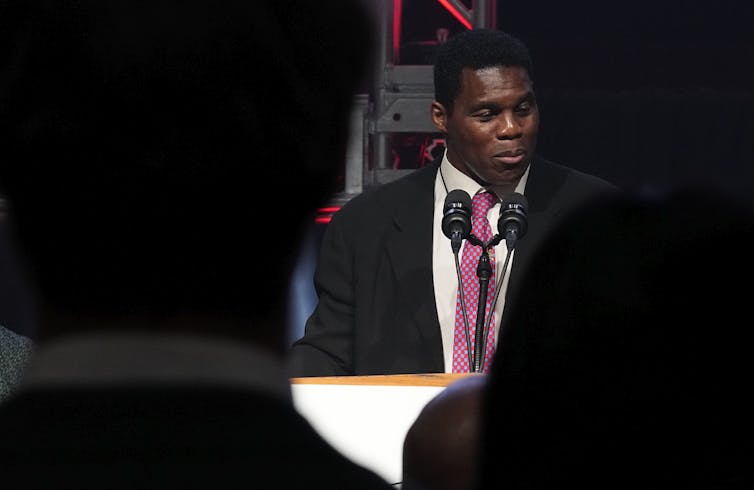
Georgia runoff: Candidate quality meant fewer Republicans turned out for Walker

Andra Gillespie, Emory University
Runoff elections tend to be races of attrition. Turnout will most likely be lower, as voters are less accustomed to turning out for off-cycle elections. Candidates, then, must try to minimize attrition among their supporters, and the one with the least erosion is most likely to win.
Such was the case in Georgia on Dec. 6, 2022. Fewer people voted for either candidate in the runoff: Sen. Raphael Warnock, the Democratic incumbent, saw the number of people who turned out to vote for him drop by about 131,000 from the November vote; Republican Herschel Walker lost closer to 200,000 voters. This would explain how Warnock was able to grow his lead in the runoff.
On turnouts and turnoffs
Overall, voter turnout in the Georgia Senate runoff election was nearly 90% of the turnout in the November general election. That’s not a huge drop-off and reflects voter interest in the outcome of a race that has been the subject of intense mobilization campaigns by both candidates in the past month.
When looking at the 10 counties with the highest proportional attrition from November to December – that is, counties where runoff turnout was only 83% to 88.1% of general election turnout – one thing stands out: They were all in metro and exurban Atlanta or north Georgia, the counties close to Tennessee and the South Carolina state line near I-85.
While some of these counties are Republican strongholds, many of them are increasingly diverse racially. Some of these counties are also rich with the college-educated white voters whom both parties covet.
Warnock earned a higher percentage of the vote in the runoff compared with November in each of these “high-attrition” counties. Walker, however, lost vote share in three of these counties.
Furthermore, in the seven high-attrition counties where both Warnock and Walker got a larger percentage of the vote than they did in November, Warnock garnered more vote share in all but the three most sparsely populated counties.
This suggests that Warnock may have won the majority of the eliminated Libertarian candidate’s votes that were up for grabs in the runoff.
There was also a nontrivial number of new runoff voters – people who voted in the runoff but not in November. We know that almost 78,000 of these new voters participated in early voting, and that this group was disproportionately voters of color – people who tend to vote Democratic.
Warnock overperformed in the most densely populated counties, too. My analysis shows that in the 10 counties that cast the most ballots in this election cycle, Warnock improved his vote share in the runoff by a range of 1 to 3.2 percentage points in each county. Walker, meanwhile, lost vote share in six of the 10 counties.
There was only one county of the top 10 – Hall County – where Walker’s increase in vote share outpaced Warnock’s increase. With the exception of Chatham County, home of Savannah, all of the vote-rich counties where Warnock gained and Walker tended to lose vote share are in metro or exurban Atlanta.
Deficiencies as a candidate
This raises the necessary but uncomfortable conversation about candidate quality. Pundits and observers had long been concerned that Walker’s deficiencies as a candidate would be a particular turnoff to suburban Republican voters, and that they might register their opposition by not voting at all. That more attrition took place in and around Atlanta suggests that there were grounds for that concern.
Walker was particularly compromised as a candidate. By standard political science measures of candidate quality – such as whether a candidate has relevant prior experience – Walker was a low-quality candidate.
His unintelligible policy pronouncements and bizarre non sequiturs about bulls and werewolves only reinforced the impression among some voters that he was not capable of handling the job of U.S. senator.
And when you compound those problems with the explosive allegations about domestic violence and pressuring girlfriends to get abortions, it looks like a small but significant sliver of likely Republican voters decided to prioritize their concerns about candidate quality over naked partisanship.
Meanwhile, Warnock has nearly two years of Senate experience and was able to draw on a modicum of incumbency advantage to help him in the contest. This was certainly reflected in his prodigious fundraising over the course of this cycle.
Yet Warnock was one of the most vulnerable Senate Democrats in this midterm election cycle for a reason. Georgia Democrats may be increasing in number and voting power, but other recent elections suggest there are still more Republican than Democratic voters in the state. Other GOP nominees in the state, such as Gov. Brian Kemp, were able to coast on that numerical advantage and Joe Biden’s net negative favorability to win decisive victories in November – without runoffs.
That Walker struggled was a signal of his weaknesses as a candidate. But many of his weaknesses and his lack of experience were known going into the primaries. That should have been enough for Republican leaders to challenge Donald Trump’s insistence that Walker was the best candidate to run against Warnock.
In the future, the Republican Party might think twice about selecting a candidate based on a party leader’s whim and not experience, substance or a demonstration of electability. If there is one lesson we can take from the 2022 Georgia Senate election, it is that candidate quality matters.![]()
Andra Gillespie, Associate Professor, Political Science, Emory University
This article is republished from The Conversation under a Creative Commons license. Read the original article.

















